I am aware, my gorgeous readers, that the blog has been languishing of late. This is down to the fact that I foolishly agreed to write a book which is, and I am not sure if you are aware of this, hard. Luckily I should have more time to spout off here now that it is all turned in, however. As a little celebration of finishing up, the other week I took a little mini-holiday to Norwich, and today I want to talk to you about some cool medieval stuff I saw there and what it means.
Now, first of all it shouldn’t be a surprise that I, a professional medieval dork, decided to pop to Norwich on holiday because it was one of the most important English cities in the medieval period. The area had been heavily settled by the Romans after Boudicca’s uprising. When they withdrew their imperialist asses, the early medieval English noticed that it was a pretty sweet spot and set up on the site of the current city at some point between the fifth and seventh centuries. The name derives from the early English “Northwic” or North Farm, which is cute.
Anyway by the time of the Viking raids, Norwich was a thriving trading centre for all of East Anglia. (That’s the bit of the island of Britain that sort of sticks out like a round bum on the west, for those not up on the UK geography.) It was important enough that it even had its own mint some time in the 920s or 930s. We have found coins that read “Norvic” across Europe, which show that its coinage was in good circulation. And indeed we have pottery shards that travelled to Norwich from the Rhineland that prove why those coins were flowing back and forth. So all in all you can tell it was pretty well connected, thriving and in it’s lane. Thriving enough that, uh, it was raided by Sweyn Forkbeard (963-1014) the Danish king round about 1004 or so. The Vikings proceeded to hang TF out for fifty years or so, and at this point Norwich was very much a part of the Danelaw, which is always fun.
The Normans eventually took it over, in that way that Normans do, and recorded it in the Domesday Book as being a big old city with somewhere between 5,000 and 10,000 people (which rivaled London, as it was somewhere around 10,000 to 12,000) that had twenty five churches. Anyway, because the Normans were Norman they locked that shit down immediately, and built a big old castle to remind everyone who was in charge now.
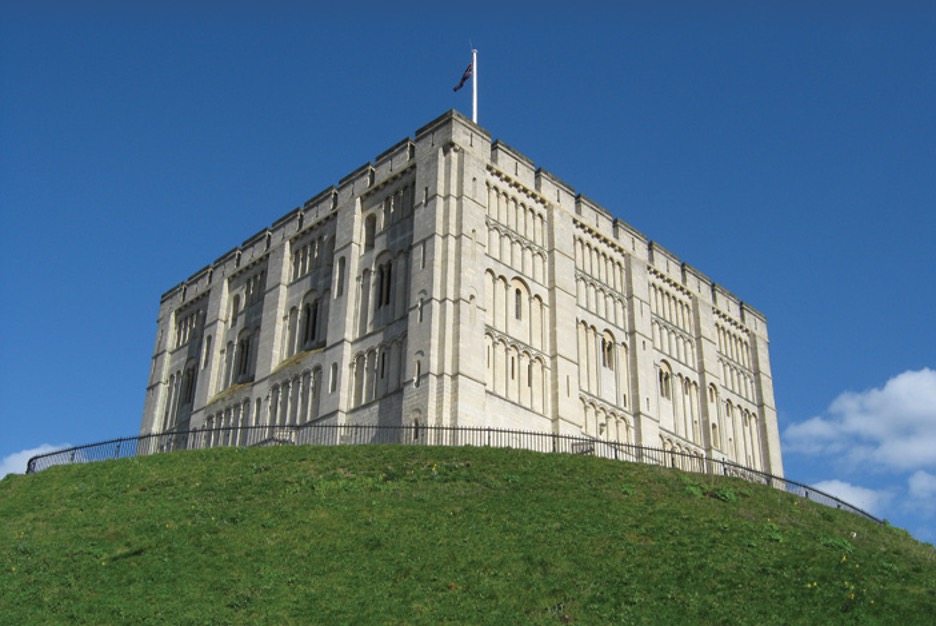
When do I want it? AS SOON AS RENOVATIONS ARE COMPLETED BECAUSE HERITAGE UPKEEP IS IMPORTANT!
Sadly for me, this was also locked down for renovations, but look at it! What a statement of power! You can see it from all over town even now, which tells us a lot about what it would have felt like for the local English when the Normans showed up. Castles are absolutely a fortress first and foremost, but they are also a powerful form of propaganda. Showing that you can build something like this, and introducing a new vernacular of architecture while you are at it, shows everyone that stuff is about to change around here.
There’s little wonder that the Normans would want to make sure they had Norwich on lock, because the reason it was so populated is that it was an ideal place to sell the one thing that medieval England really had going for it – wool. I know I am always telling you about wool, but that’s because it is so so so important in the medieval Europe. In a world without central heating you would be way more interested in wearing woolen garments than you are now. And if you work outside in all weathers you had better believe you would be interested in wearing a fibre that stays warm even when it is wet. And it turns out that it is pretty easy to raise some sheep over in East Anglia. However, all that wool needs to be got in from the fields and then traded out, and Norwich was perfectly placed to do that because it was on a nice big river, the Wensun, which leads to the Yare, that dumps you right out in the North Sea. From there you are ready to take that wool over to the cloth makers in the lowlands. So as far as the Normans were concerned they needed to lock that down immediately.
In order to show that they had a handle on the situation, the Normans also began construction on Norwich Cathedral in 1096. It was completed in 1145, which is fairly speedy as cathedrals go, and oh my word is she a beauty.

In and of itself the cathedral is a masterpiece of Norman architecture, and in a religious capacity is doing exactly the same thing that the castle is doing. It served to reinforce the fact that a new ruling class was in the city and that things would be done in a certain way as a result. However, unlike the castle it gave the local population something to be happy about. A cathedral puts you on the map. It is one of the things required to show that you aren’t just a town but a city. Quite literally. It also means that if you have ecclesiastical issues you can go to the bishop more easily. Plus it’s super pretty. That stuff matters to the local populace. You build them something beautiful and useful and they are a lot less likely to get het up about the fact that you have taken over. And, let’s be real, it’s not like there hadn’t been a lot of different invasions around the joint lately. At least this way they got something nice out of the deal.
If you are enjoying this post, why not support the blog by subscribing to the Patreon, from as little as £ 1 per month? It keeps the blog going, and you also get extra content. If not, that is chill too.
Now, for me, one of the most incredible things about the cathedral is the collection of bosses, which are the sort of little cap stones that you can find in the ceiling, like so:
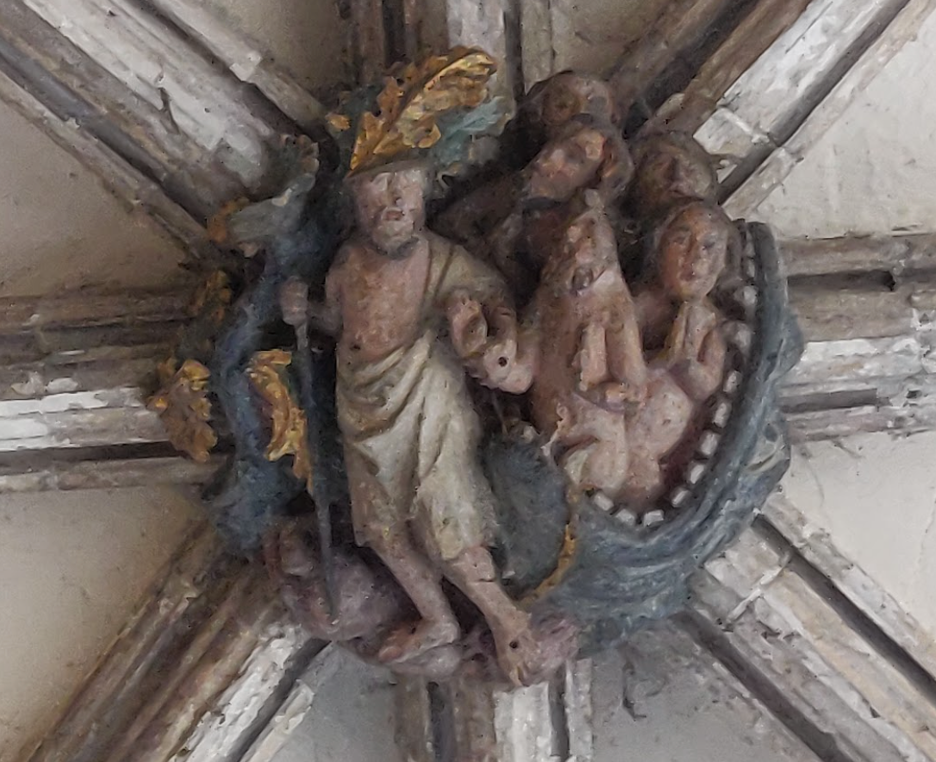
Now, as you can see, these absolutely whip, and are an anomaly in terms of English cathedrals. This is because incredibly cool, fun, good, and beautiful stuff like this was targeted first during enemy of the blog Henry VIII’s (1491-1547) break from the Catholic Church, and then later by the hated Puritans during the English Civil War. I am not exactly sure why these beauties made it through, but I am delighted that they did because they give you a great idea of what medieval churches would have looked like because they have so much detail and – crucially – are still painted.
Bosses like this serve a really special purpose. In a world that is largely illiterate they serve to reinforce biblical stories, and the bosses in the cloister are telling one of my favourite stories – that of the Apocalypse.
When you first get out into the cloister the Apocalypse stuff isn’t immediately clear and I was just vibing TF out checking out stuff like the Virgin with a unicorn, which is absolutely very cool.

And then suddenly there he was the Beast of the Abyss.
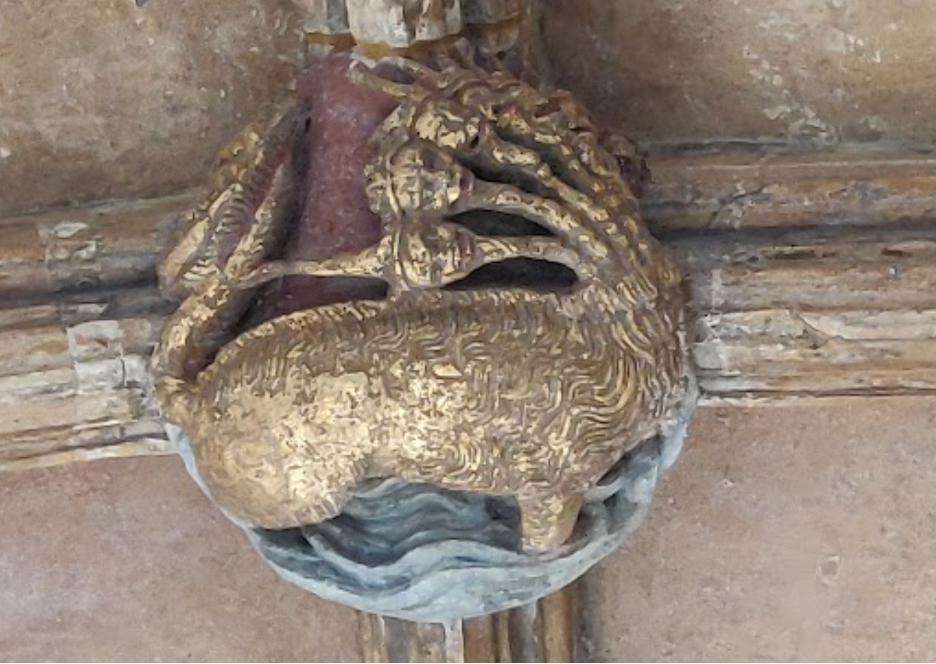
The Beast from the Abyss shows up three times in The Apocalypse/Revelation in chapters, eleven, thirteen, and seventeen. Eleven is all about him making his grand entrance ascending out of the bottomless put to kill the prophets Enoch and Elias. We learn in chapter thirteen that he is meant to look like a leopard, with feet like a bear, and a mouth like a lion. This is based on some of the Danieline visions, which have a lot of cool little monsters in them too, and which I will eventually get around to also writing about. Anyway, in Revelation seventeen we learn that the Beast also has seven heads, ten horns, and is scarlet coloured. That sort of comes and goes in this Apocalypse cycle but man oh man HE IS VERY SCARLET WHEN HE SHOWS UP WITH THE WHORE OF BABYLON RIDING HIM!!!

Now you must imagine that when I saw this I pretty much did the Leonardo DiCaprio pointing at the TV meme, because the Whore of Babylon is very much the symbol of this blog and I simply love to see my girl thriving and also ruling over the kings of the earth, as you can see here. She is getting drunk on the blood of the martyrs and having a nice little ride on the beast, as one does.
But the Apocalypse doesn’t just have one beast – it has two – AND SO DO THE BOSSES!!! And so here is our homie the Beast from the Earth. This is my guy here:
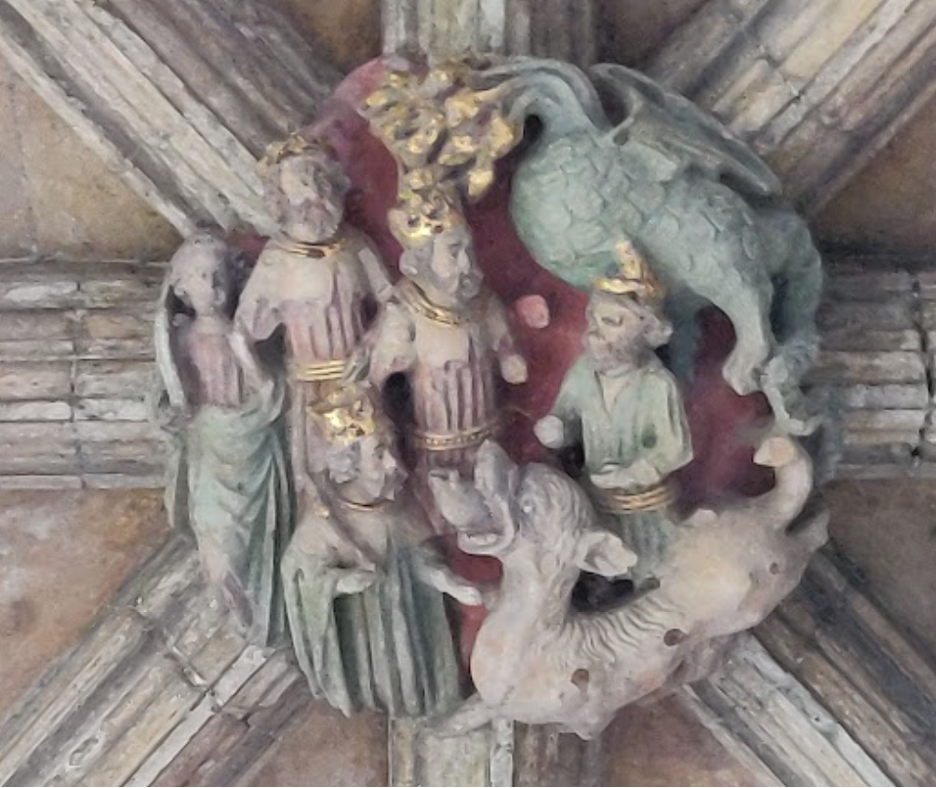
He doesn’t really get described in the Apocalypse other than as having two horns like a lamb and speaking like a dragon. But here it seems that they have rendered him as dragon-like, which I think is a really nice touch. He essentially acts as a hype man to the Beast of the Abyss as well as a false prophet. He goes around telling everyone that if they don’t worship the beast of the Abyss then they will be killed. He can also breath life into images of the Beast of the Abyss and make it talk. So that’s what’s up here. He’s doing a little warn of all the kings of the earth and animating an image of a beast.
Really interestingly, the cathedral artists made the decision to use this second beast repeatedly in places that you wouldn’t necessarily expect to see him. For example, he shows up to threaten the Woman of the Apocalypse (or the woman clothed in the sun) who shows up in Revelation chapter twelve. Here she is giving birth to a son, which the dragon wants to devour. Traditionally, you would just expect a regular old dragon to be doing that, but here the artist uses his Earth Beast dragon to do the threatening:
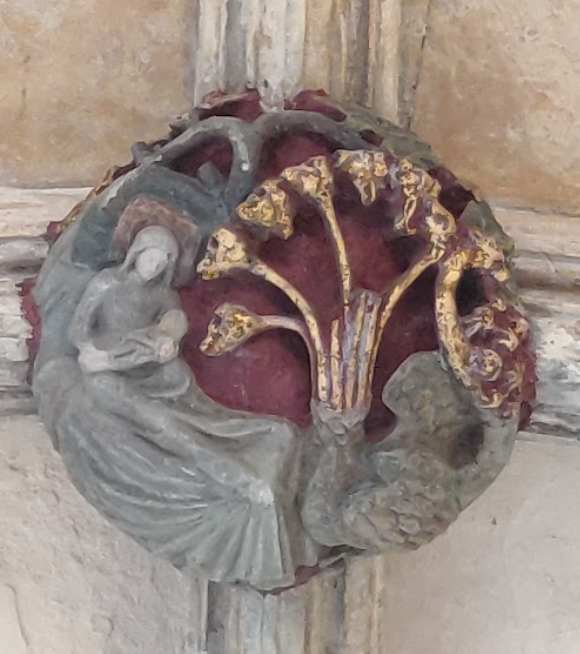
I am absolutely in love with this choice, which shows us that medieval people had varying ways of interpreting these biblical stories, or maybe they just liked the little monsters they had come up with here and wanted to use them again. Either way, I was able to read the story in a standard manner, largely because it was presented in an order that I expected, so this piece of artistic license absolutely works without interrupting narrative flow.
The standard story about the woman is able to fly away from the dragon hiding first in the wilderness, and then escaping on the wings of an eagle. The dragon then inundates her hiding place with flood waters, which you can see here:
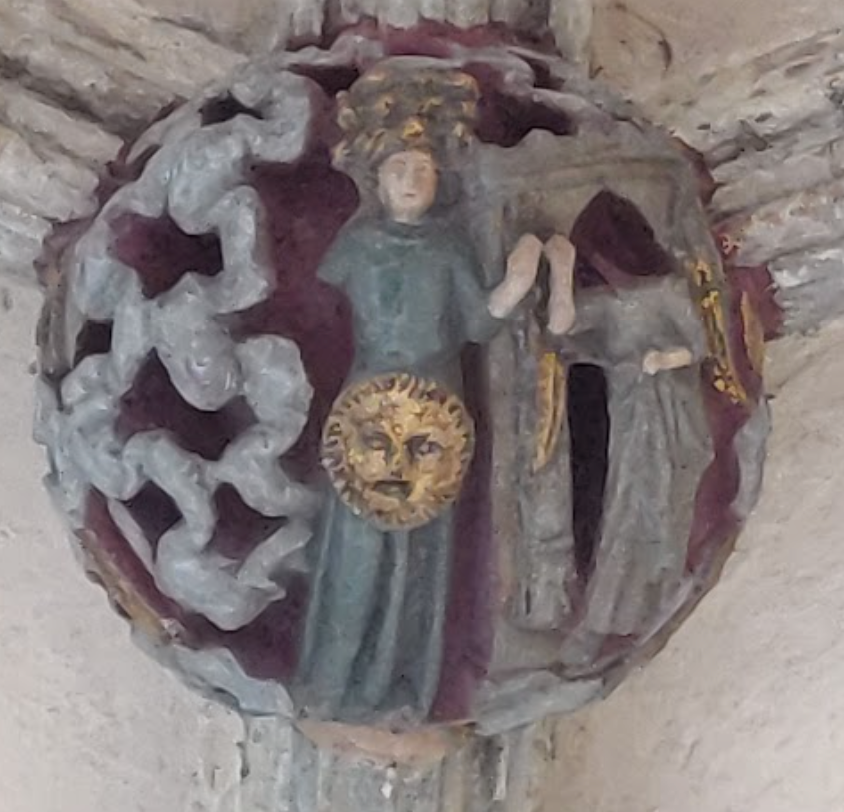
I have roughly a thousand pictures of the various bosses in the cloister, and while I would love to show you them all, there is a reason that I chose to show you these various bits of the Apocalypse cycle. And that’s because, well, you know how I mentioned earlier how most people were “illiterate” when the cathedral was built? Well in a lot of ways they were way better at reading symbols and images than we are now. This is a form of literacy that is every bit as important as reading.
I can easily look at these capital bosses and tell you what they mean because I am a giant nerd who destroyed her entire life to get really good at finding the Beast of the Abyss in art. I would be pretty willing to bet that a lot of people – well educated, smart, talented, and well-informed people – could not do this same thing if presented with these bosses. For medieval Europeans, on the other hand, this was just par for the course. Sure, they might not be able to read the Apocalypse, but they could probably narrate the whole thing for you, especially with these images as guides.
And it is this that the castle, the cathedral as a building, and these bosses had in common – they are all sophisticated forms of communication that we don’t tend to consider. None of these choices happened in a vacuum. Placing a castle high on a motte overlooking a newly conquered and thriving city is a specific political choice. Constructing a cathedral in the conquerors’ architectural style in a nod to the city’s importance is another. Creating a cycle of artistic reminders of the tenets of Christianity for the conquered to contemplate is one as well. All of these things combine to remind the people of Norwich that they are have new rulers, yes. But they also remind them that there are concrete benefits to allowing them to get on with the job.
When we learn to read buildings in the same way that medieval people did, it can help us to enrich our own understanding of place and power in really exciting ways. It also means that you can have an absolutely cracking little holiday in important regional towns like Norwich. I’m telling you. Try it.
For more on church architecture, see:
Look up – this church is judging you
For more on Apocalypticism, see:
The Medieval Sex Apocalypse on Drinking with Historians
On Jerusalem and the Apocalypse, or why you should be deeply unsettled right now
Emergency Pubcast – Why the Pope can’t just say there’s no hell and do me like that
On Mike Pence, Holocaust Memorial Day, and Christian interpretations of Jewish utility
On Jezebel, makeup, and other apocalyptic signs
Support the blog by subscribing to the Patreon, from as little as £ 1 per month! It’s the cool thing to do!
My book, The Once And Future Sex: Going Medieval on Women’s Roles in Society, is out now.
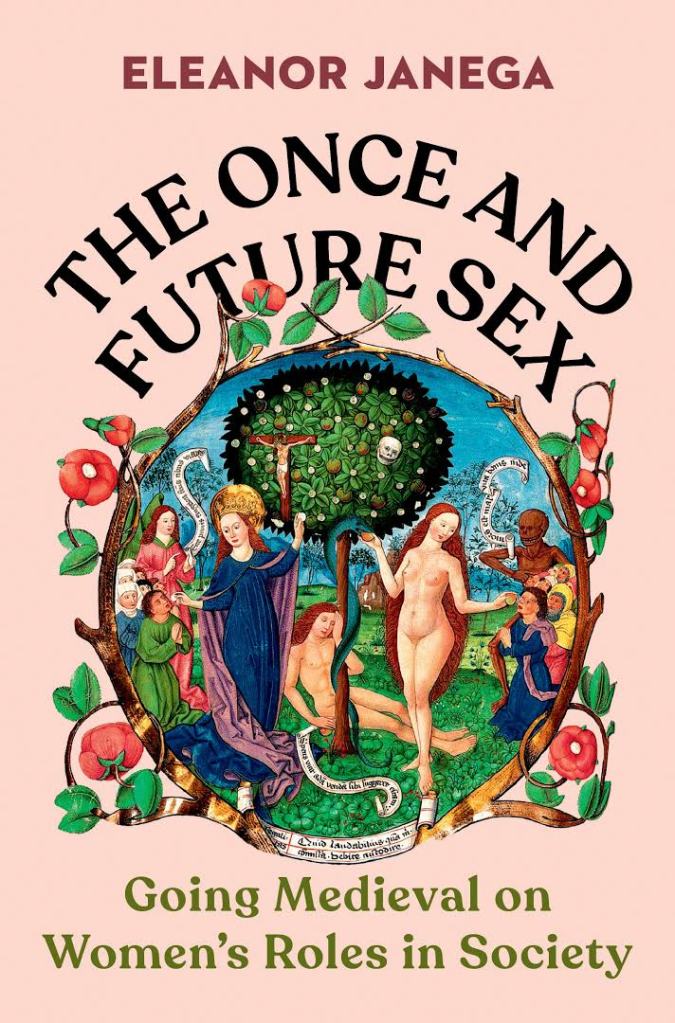
© Eleanor Janega, 2024

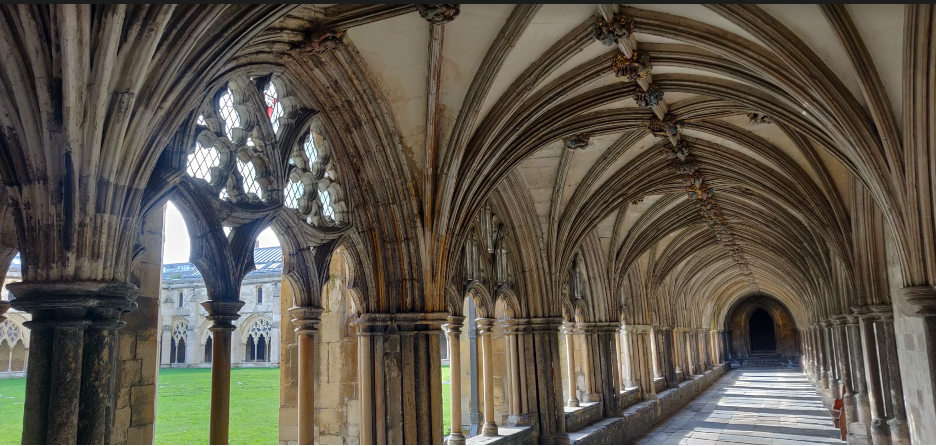
I remember that the stone at the bottom of Norwich Cathedral was a different colour to the stone higher up because it had been ‘cooked’ (not sure of the science) during the 1272 rebellion when the Cathedral was burned during a fracas between priory and citizens
LikeLike